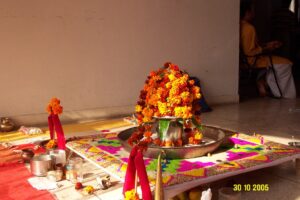Anushthan
Anushthan
Anusthan can be started in any month. Panchmi, Ekadshi, Poornmasi are considered auspicious days to begin. The attributes of Durga, Saraswati and Lakshyami are prominent on Panchami, Ekadashi and Pooranmasi respectively. There is no bar of Shukla or Krishna paksha, although Shukla-paksha is considered more auspicious for अनुष्ठान.
During Anusthan, Gayatri should be invoked before starting and reverently bidden to leave at the end of worship daily. In this process, sentiments and prayer play the key role. The presence of divine, kindhearted, affectionate Universal Mother Gayatri should be invoked by praying in Sanskrit or in one’s own mother tongue. It should be believed that accepting the prayer, the Mother has been kind enough to appear. At the time of Visarjan (leaving), the divine all powerful Mother should be prayed to in Sanskrit or in one’s own language to kindly leave and it should be believed that, accepting the prayer, She has left.

There is reference in several books that Yagya (offering in sacrificial fire) of one-tenth of total amount of Jap and Tarpan of one-tenth of Yagya should be performed and one-tenth proportion of Tarpan should be devoted to feeding Brahmans. But this rule applies to Anusthan done by Tantrik method only. In Anushtan performed according to the way of Vedik Yog system Tarpan is not necessary. But at the end of Anusthan, Yagya of at least 108 Ahuti offerings in sacrificial fire has to be performed although more can be done if it is convenient.
Similarly, at least three Brahmans should be fed. No limit has been prescribed for offering money in charity. It may be done according to Sadhak’s resources and faith. In Nirakar worship Bhagwati Gayatri should be installed as Shakti on an altar decorated with beautiful flowers. In Sakar worship a beautiful picture or image of Bhagwati may be installed on such an altar decorated with flowers. Some Sadhaks invoke Bhagwati in the spark of incense-stick or in the pointed flame of the lighted lamp kept on the altar and feel the presence of their adorable Deity. At the time of Visarjan, the idol/picture should be made to sleep and should be removed and immersed in some river, tank or holy place. Half-burnt incense-sticks or wick of the lamp should be extinguished and should also be immersed along with the flowers. Half-burnt wick should not be used the next day.
Five articles have mainly been considered essential and auspicious in Gayatri worship. Incense should be burnt, lamp should be lighted, naivedya (sweet offering) should be offered, sandal-wood paste should be applied and rice should be scattered. If Gayatri has been installed in the form of a lighted lamp, a water pot should be kept as fifth article of worship.
The Sadhak should sit in the morning on clean, ground on a carpet of Kush, facing the East, and keep a pot of water close by. The lamp should remain lighted and incense should burn throughout the Jap. If the lamp is extinguished, it should be relighted by placing a new wick in it. The Ghrit remaining in the lamp can be used again. Jap should be started immediately after installation and worship of Gayatri on the altar. This should be the daily routine. Mind should be steady and full of devotion during Jap. Whenever it goes astray, it should be reined in, brought under control and concentration practised. By this method power of concentration will develop day by day.
The system of completing Jap of 1,25,000 Mantras in forty days is in vogue since ancient times. But a weak person or those who are not habituated by earlier practice may complete it within two months. The number of daily Jap of twenty rosaries or malas (of 108 Mantras each) should be done daily. To facilitate counting of rosaries or malas, small tablets of chalk clay wetted with Ganga water should be kept at one place. Jap should be closed when all the tablets are collected at the other end. There are no chances of error if such a system is adopted.
